How to optimize breathing during surfing ?
A Training and guidance program for surf travelers to increase their lung capacity
Free falling from the top of the wave, on a missed take off. Find yourself suck to the bottom after being locked in the foam of a washing machine that mashes you, not being able to hold your breath, gasping for air and think this is it, surfing was a fun sport, but you're going to drown !
We all already lived such mishaps on spots, at home or abroad during our vacation.
In fact, inevitably in these occasions, the first enemy is panic. We stirs arms and legs to try to reach the surface and remain in the axis. But all these wild gestures do only one thing : burn precious oxygen that remains in your lungs, increase the panic that speeds up your heart rate. Not to mention that you'll need more breath to avoid other series of waves that break continuously, then swim to the edge, cause with a little extra luck, your leash will be broken.
Over the years, several techniques have been developed for the management of wipeouts in surfing and imprisonment beneath the waves. We talk about medium-sized to solid waves, not Big Surf, which is an extreme sport practiced by a handful of highly trained guys, and that will be another matter.
Do not panic... Easy to say ! Especially when you irresistibly feels crashed to the bottom, when you are no longer able to distinguish the bottom from the surface and sometimes hits the bottom, rocks or reef.
It must be assumed that only a specific training will be profitable. As you will travel to a destination where you do not know the spots, currents and funds or logistics in case of serious problems, it is best to be prepared upon these different aspects.
Hypoxic basic training program
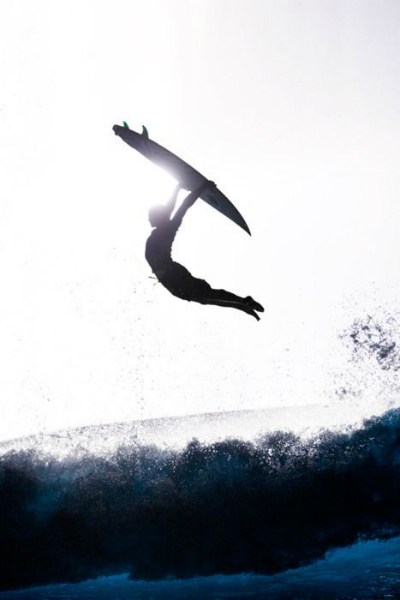
Hipoxie, whatizthat ? Hypoxia is the result of hypoxemia (decreased oxygen in the blood) as dictionary tells us. Well, ok, I don't feel it...
Clearly, you'll have to have a swimmer rib cage (added benefit, you will have a hottie look ...) No need to shave your body, it's useless unless you want to also swim in pool or go cycling.
Thus, you will increase your oxygen reserves, gaining precious seconds underwater. The technique involves a slow, deep swimming, with long periods head under water (but that's only the beginning)
Starting training at the end of summer, has the double advantage of allowing you to be ready to travel into the heart of winter, when usually your body is at the bottom of its physical form, but also sharpen yourself for the sunny days in Europe and won't spit your lungs in the early spring sessions.
So LET'S GO WORKING !
- First, find a pool near home (snorkeling in your tub is not patented)
- Train at least 4 times a week. Otherwise you will not make significant progress.
- Start the first two weeks training by 10 minutes swim without forcing, to raise the heart rate normally.
- Swim 4x50 meters crawl, breathe every four strokes, then take 30 seconds of pause every 50 meters. Take 60 seconds pause after the last 50 meters.
- Swim 2x100 meters freestyle, breathing every four strokes, then 60 seconds of pause every 100 meters. Take 60 seconds pause after the last 100 meters.
- Finish the session with 4x25 meters freestyle, breathing once on the distance
- Coming out of the water, stay hydrated by drinking plenty of water (It's not because you are in the water that your body does not need it, on the contrary) and relax yourself quiet at home (avoid videos of Nazaré or Mavericks).
Hypoxic evolved training program

To become a kind as in the movie The Big Blue, then let's strart serious business...
- The following two weeks (at a rate of at least 3 sessions per week) Continue with 2 sets of 12x25 meters crawl, swim and cool at your own pace without forcing as a mule.
- Take 30 seconds pause after each 25 meters and at least 3 minutes of pause at the end of your series of 12x25 meters.
- Each week, reduce the number of inspirations. First delete one breath every 4 strokes, and increase of one stroke every week until you get to 8 strokes.
OK, you hear me ?
- When you feel more comfortable with your breath level, you can increase the swimming distance. Then, when you feel comfortable, you can then increase swimming speed, alternating fast and slow phases.
- At the end of each session, after several minutes of rest, try to swim underwater as far as you can by measuring the distance traveled. Do not force, let your body do it. Make a progress point after six weeks.
Additional Training Tips

Calm water or pool swimming :
- Remove your leash with closed eyes underwater. First in normal position then upside down. This training is useful for surfing on coral slabs or rock crevices where the leash can get stuck and keep you at the bottom. This will prevent a fatal accident.
- Dive 2 m deep, empty your lungs slowly through your nose to stay in depth. Keep some air for the rest of exercice. Underwater, perform 4 somersaults in one direction, then reward, eyes closed.
Curl up into a ball and mentally observe your position. Guess where is the surface without opening your eyes. Wait until your lungs explode and open your eyes.
You should get some oxygen to climb to the surface slowly, your body streched. In this way you'll get used to manage panic of the fall.
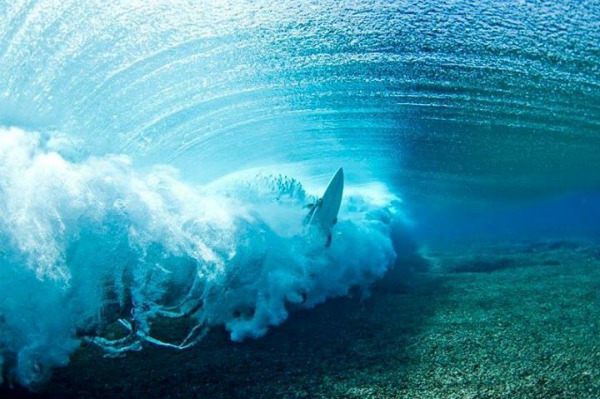 In waves :
In waves :
- If you are on a sandy beach, train to get rolled into the shorebreak (of course without your board) trying to control the fall and inconvenience of rolled-balls, outstretching as little as possible your limbs.
- Go swimming with bodyboard flippers. Go through the waves sets, come back bodysurfing the waves, leaving yourself going to the bottom.
20-minute session, including during days when waves are mushy or even strong strong, is also a great workout.
But remember also :
- During a wipeout, empty your lungs 2/3 underwater before reaching the surface. You will be able to take a stronger breath at the surface, rather than if your lungs are still full of oxygen, saturated with carbon dioxide (tip by Mark Visser, a regular of this type of training).
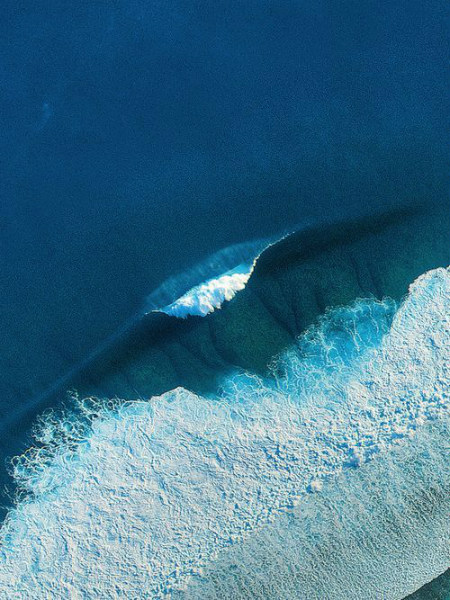
- Always paddle arching, legs together, head down. You'll open your chest, have better breath and will be promoting your paddling power.
- Always try to fall protecting your head with your arms outstretched. This defensive position is useful not to hurt your skull and face by hitting bottom, or get cervical fracture, but also rising to the surface to avoid the risk of taking your board in the face, or that of another surfer...
- On reef bottom, learn to fall "flat", if possible on the back. Use water as a cushioning pad. In the foam, keep the legs and arms spread to maintain the waterline.
Never dive head first, you'll risk breaking your neck and smash your skull. If you cannot do otherwise, on a late take off for example, try to turn yourself into the air to land on water, as flat as possible on your back or put yourself into a ball position.
- File down your fins with thin sandpaper to avoid being cut into slices or puncture the skull.
- Install a good old "Nose guard" or plan to shape your next board with a rounded nose. Use a long, solid leash, depending on the size of the waves on the destination where you go. This will save you from a brutal kickback of your board in the face or injuring your eyes.
- Do not go into the water immediately without having examined the spot. Watching the surfers in the water, you can make out the peak area, currents, channels and frequency of the waves. Do not hesitate to ask locals about conditions and the evolution of swell, wind, during your stay.
- Report your friends or your hotel when and where you go surfing.
- Warm up. Even if you are in a tropical country. You will avoid tears and spin and shoulder problems, and of course, stretch and hydrate after the session. Long minutes of stretching / yoga is an excellent addition to your workout.
- To avoid abrasions and deep wounds to your feet caused by the coral when surfing the reef, consider bringing a pair of hard-soled slippers.
- On hard and hollow spots, on coral slab, plan a helmet Gath type or a ear, forehead, protection as the Surf Muff.
If surfing is a sport synonymous with fun and exoticism, remember the rule that the ocean will always be stronger than you and your reasoning.
No unnecessary risks, you are on vacation with your friends or family. So give them prevention tips, useful training. Your travel and surf sessions will be a pleasure and you will feel sharper to enjoy the waves and spots of the destination.
In the meantime, take a look at the video below with Gaby Reece, Laird Hamilton lovely wife and our God Kelly, who show special movements that you can experiment to gain fluency underwater.

Jean Révé
Working for several years in tourism in France and abroad, Jean-Hervé Cristol (aka Jean Révé) also has a large number of kilometer mark traveling around Planet Surf in search of endless summer waves.
In 2004 he created Destination Surf, the first agency specialized in Surf Travel , then Endless Summer a blog with tips, info and travel stories, in order to enjoy and share this rewarding experience with all surf travelers. → Learn more




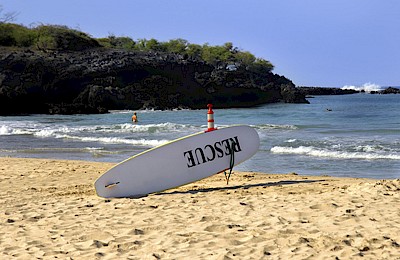
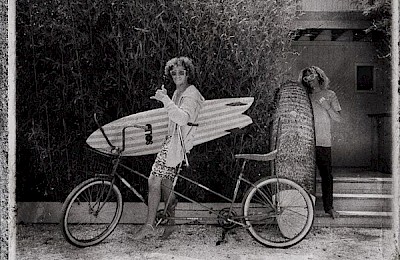
Show Comments ...
Leave a comment